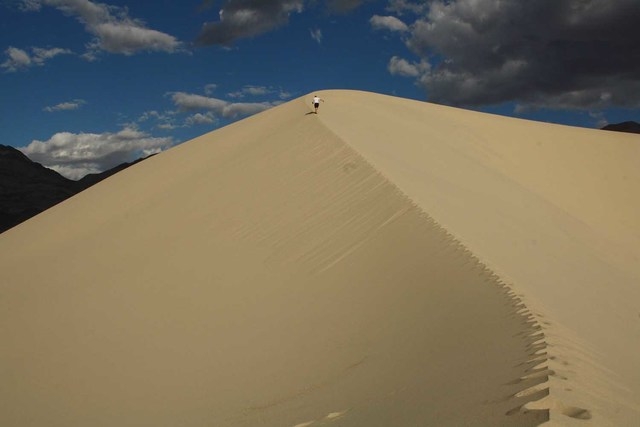
Some of the tallest sand dunes in North America can be found in the remote and extreme northern section of Death Valley National Park, California.
The Eureka Dunes, located in the enclosed Eureka Valley, have a base elevation of about 3,000 feet so this is an ideal time to visit them before the temperatures warm up.
The dunes rise up nearly 700 feet more along a formation that is about three miles long from north to south, and one mile wide.
Unlike many dunes in the southwest, these are closed to all OHV vehicles, horseback riders and sandboarders. But you can walk, run or roll to your heart’s content.
Of course one of the most satisfying activities is walking to the highest peak. The easiest way to do this is to park in the camping area and head up the dunes from their northwest corner.
This route has a more gradual slope than other approaches so the uphill travel is a little easier. Once you reach the first peaks, you can follow an undulating ridgeline toward the southeast, where the summit lies.
The dunes are about 10,000 years old and are very stable. They lie in the enclosed Eureka Valley; to their east, the rugged, limestone Last Chance Mountains rise some four thousand feet.
In 1984 the Department of the Interior designated the dunes a National Natural Landmark.
When the sand is very dry, these dunes are known to “sing” or “boom,” meaning that strange sounds are heard when sand avalanches down the faces of steep sections. Some describe the sounds as resembling that of an airplane passing overhead, or a deep note from an organ.
It is not entirely clear what makes the sounds but some theorize that they result from the friction of sand grains sliding against each other.
Only about 35 desert locations around the world exhibit this phenomenon. One is the Panamint Dunes, also in Death Valley. Another is Kelso Dunes, in California’s Mojave National Preserve. In Nevada are Big Dune in the Amargosa Valley, Sand Mountain near Fallon, and Crescent Dunes near Tonopah.
The Eureka Dunes are home to five endemic species of beetles and three endemic plants — Eureka dunegrass, Eureka Dunes evening primrose and shining milkvetch. You probably won’t see too much wildlife during your visit except, perhaps, some black-tailed jackrabbits.
You might hear a coyote or two during the night. With luck you’ll neither see nor hear a rattlesnake, but watch your step, especially at night, for they do live here.
Because of the dunes’ remote location in the park, camping is the best way to visit. There are about 10 designated dry camping spots at the northern base of the dunes, and some of the sites have fire rings and picnic tables.
Be sure to bring plenty of water, have a full gas tank before you set out and bring all your own food and supplies, as there are no services close by. There are no electrical hookups here for RV’s so you can look forward to absolutely dark skies bejeweled by countless stars.
Since we are into Death Valley’s most popular season, even in the remote spots, it would be best to arrive early in the day to be sure of getting one of the first come, first serve sites.
From the park’s central visitor center at Furnace Creek, it is about 97 miles to Eureka Dunes. The Big Pine/Death Valley Road travels north and then heads west over to Eureka Valley. The gravel road is rough in many spots except for the final four-mile section to the Eureka Dune access road turn-off, which is paved.
The access road is a 10-mile gravel road which is also fairly rough but can be done in vehicles with high clearance and good tires, unless it rains.
Deborah Wall is the author of “Base Camp Las Vegas, Hiking the Southwestern States,” “Great Hikes, A Cerca Country Guide,” and co-author of “Access For All, Touring the Southwest with Limited Mobility.” Wall can be reached at Deborabus@aol.com.